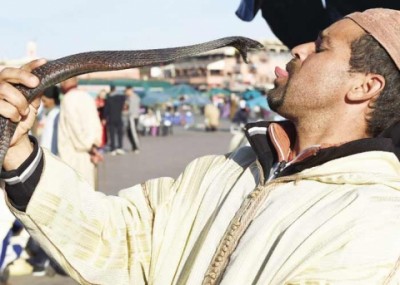Travel & Tourism
Global Arab Network
Today Marrakech is filled with stylish boutique properties built from homes within medina often abandoned or sold cheaply by locals, in many cases, to European visitors.
In 1971, I experienced what almost seemed like being an actor in a Fellini film. The sounds of bells clanging, strange and eerie sounding music, voices of a foreign language calling out, snake charmers, monkeys and throngs of men wearing costumes of a myriad of colours approaching.
There was no way to describe the scene as being anything less than bizarre. Even now, these activities in Marrakech’s fabled Jemaa el Fna have changed little.
Still the heart of Marrakech, the square has more people than ever. It is the city of Marrakech and its surroundings that have grown to nearly 2 million inhabitants, drawing hundreds of thousands of tourists for its regional offerings and providing employment to a country where jobs are the best preventive medicine from seeing the type of political revolutions that have plagued so many Arab countries of North Africa and the Middle East.
Moroccan tourism authorities have made Marrakech a destination, not only for those who spend their days in the square and exploring the medina of Marrakech and the visitors’ average stay is three or four nights, often spending hundreds of dollars per night to stay in the medina’s many trendy and sophisticated riads, homes of people who have long since departed for Marrakech’s suburbs, or as émigrés to Europe. Gone are the days when staying in the fabled La Mamounia was the sign of prestige. Today Marrakech is filled with stylish boutique properties built from the homes within the medina often abandoned or sold cheaply years ago by locals, in many cases, to European visitors who saw the potential of these architecturally rich abodes.
Estimates are that there are more than 300 riads in the region of Marrakech, some with housing-exclusive restaurants, where dining results in the fine art of blending Moroccan herbs and spices with the creative culinary skills by the chefs who look for new ways to bring out these flavours.
Tourists arrive from all over, with Europe being the primary source. Low-cost airlines resulting from Morocco’s entrance into Open Skies agreements allow weekender visitors as well as long-term travellers to reach Marrakech for less than $125 with little advance planning.
The city’s reputation for hospitality has grown tremendously. Marrakech’s airport is an active place where the Ryanair and EasyJet discount flights fly people in on a near daily basis, while charters and other scheduled airlines see the importance of this growing market as well.
Americans have become a growing percentage of the visitors to Marrakech. And they are not first flying to New York to come with Royal Air Maroc!
“They fly the major European airlines in combined codeshares such as Delta and Air France to Paris, do their visits to Paris or London and then hop down to Marrakech with the discount airlines,” my Moroccan guide said.
These Americans are not the backpackers of past decades looking for the path of hash and kif that brought the “hippy trail” of the 1960s and 1970s. Today’s travellers, particularly those coming from the United States, are reading about “trendy Marrakech” and the many sophisticated riads and celebrated chefs who are finding Marrakech a mecca for those who want to feel exotica during the day but enjoy their nights with a sophisticated meal and a nice bottle of Moroccan red wine. It is not just the charms and exotic nature of Marrakech itself that attracts visitors. A visitor to the region can easily use Marrakech as a base for day trips into the mountains surrounding the valley, where one can visit Berber villages and enjoy traditional meals as they have been prepared for generations.
Tours to the forts of yesteryear, the fabled treasures of Ouarzazate and other villages whose exotic settings have become the backdrops for movie sets and also home to chic, boutique escapes.
Cooking classes are added to the cultural tourism of Marrakech. There are many options fully set up to teach up to eight classes for half-day programmes.
Marrakech also bills itself a golf destination. Golf bags strung over the shoulders of visiting Europeans arriving at the Marrakech airport signal the lure of the mild climate for the northern European looking to play golf in January at a fraction of the cost of doing so in Europe.
The level of building in this desert landscape seems inexhaustible, with the Zone Touristique playing host to hotel after hotel of four or five stars providing the full amenities of self-contained hospitality.
So, what has allowed Marrakech tourism to grow at such a rate at a time when most of the Arab world’s tourism is either non-existent or suffering in the doldrums?
“We are seen as a stable country,” notes my guide, a Berber from the south. “When the ‘Arab spring’ came to the region, we barely had a protest. The king instituted new reforms, did what he did to release any possible tension and stability continued without missing a beat.”
So, if the Arab world has seen a winner emerge from the chaos that has followed the 2011 upheaval, Morocco and Marrakech can claim to be that one.
The Arab Weekly
By: Jerry Sorkin is founder and president of Iconic Journeys Worldwide and of TunisUSA. He is a frequent contributor to The Arab Weekly.








